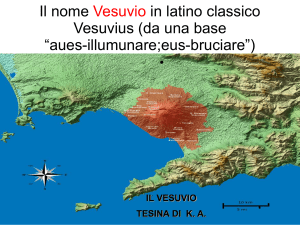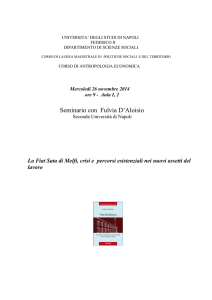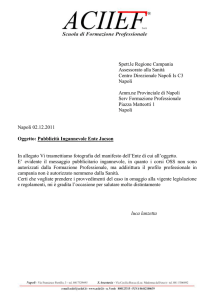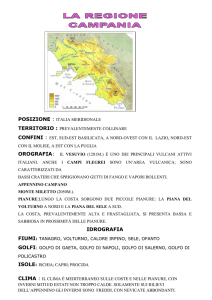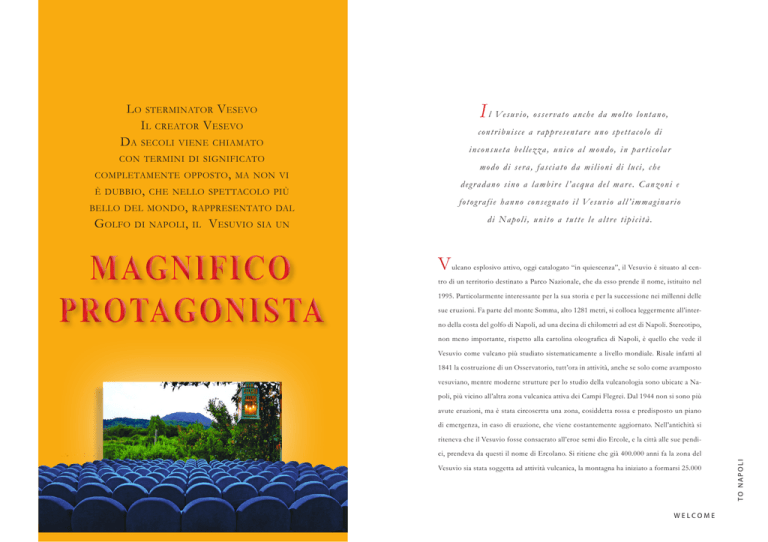
I l Ve s u v i o, o s s e r v a t o a n c h e d a m o l t o l o n t a n o,
Lo sterminator V esevo
I l creator V esevo
Da secoli viene chiamato
contribuisce a rappresentare uno spettacolo di
i n c o n s u e t a b e l l e z z a , u n i c o a l m o n d o, i n p a r t i c o l a r
con termini di significato
modo di sera, fasciato da milioni di luci, che
completamente opposto , ma non vi
degradano sino a lambir e l’acqua del mar e. Canzoni e
è dubbio , che nello spettacolo più
f o t o g r a f i e h a n n o c o n s e g n a t o i l Ve s u v i o a l l ’ i m m a g i n a r i o
bello del mondo , rappresentato dal
Golfo
di napoli , il
V esuvio
di Napoli, unito a tutte le altre tipicità.
sia un
MAGNIFICO
PROTAGONISTA
V
ulcano esplosivo attivo, oggi catalogato “in quiescenza”, il Vesuvio è situato al cen-
tro di un territorio destinato a Parco Nazionale, che da esso prende il nome, istituito nel
1995. Particolarmente interessante per la sua storia e per la successione nei millenni delle
sue eruzioni. Fa parte del monte Somma, alto 1281 metri, si colloca leggermente all’interno della costa del golfo di Napoli, ad una decina di chilometri ad est di Napoli. Stereotipo,
non meno importante, rispetto alla cartolina oleografica di Napoli, è quello che vede il
Vesuvio come vulcano più studiato sistematicamente a livello mondiale. Risale infatti al
1841 la costruzione di un Osservatorio, tutt’ora in attività, anche se solo come avamposto
vesuviano, mentre moderne strutture per lo studio della vulcanologia sono ubicate a Napoli, più vicino all’altra zona vulcanica attiva dei Campi Flegrei. Dal 1944 non si sono più
avute eruzioni, ma è stata circoscrtta una zona, cosiddetta rossa e predisposto un piano
di emergenza, in caso di eruzione, che viene costantemente aggiornato. Nell’antichità si
riteneva che il Vesuvio fosse consacrato all’eroe semi dio Ercole, e la città alle sue pendi-
Vesuvio sia stata soggetta ad attività vulcanica, la montagna ha iniziato a formarsi 25.000
TO NAPOLI
WELCOME
TO NAPOLI
ci, prendeva da questi il nome di Ercolano. Si ritiene che già 400.000 anni fa la zona del
anni fa, probabilmente come vulcano sottomarino nel Golfo di Napoli, poi emerso successivamente
come isola, unito alla terraferma per accumulo di materiali eiattati. Tra i 19.000 anni fa e il 79 d. C. si
annovera una fitta serie di violente eruzioni, intervallate con periodi di quiete assoluta del vulcano. Il
Parco Nazionale del Vesuvio offre molte possibilità di escursioni, come itinerari con osservazione di
rocce vulcaniche e passeggiate attraverso fitti boschi e distese di lava e resti di antiche città distrutte
dalle eruzioni passate. Alcune, per essere visitate, richiedono un cammino a piedi, mentre altre possono essere ammirate senza allontanarsi dall’auto o dal pullman. Si possono vedere da vicino i percorsi
di Lava, oramai pietrificata, che come fiumi hanno percorso i lati del vulcano inondando i valloni, proprio come vviene per i torrenti d’acqua, nell’avanzamento verso valle. La fisionomia del Vesuvio si è
modificata man mano nel tempo. Fu probabilmente l’eruzione del 79 d. C. a far nascere, all’interno del
Monte Somma, il nuovo cono vulcanico. Da allora, dopo ogni eruzione, la montagna è apparsa diversa
per forma ed altezza. Nel 1631 e nel 1906 si abbassò, mentre le lave del 1944 l’alzarono di circa cento
metri. Il cratere oggi ha un diametro di circa 500 metri e una profondità di 230 dal punto più basso
dell’orlo, la cui quota oscilla tra 1.150 e i 1281 metri. Sul lato meridionale, a pochi passi dal sentiero
percorso dai turisti, alcune fumarole emettono gas a circa 80 °C di temperatura. Un’altra fumarola più
Active explosive volcano, now cataloged “retired”, Vesuvius is located in the center of an area destined
has been subject to volcanic activity, the mountain started forming 25,000 years ago, probably as a
to the National Park which takes its name from it and established
submarine volcano in the Gulf of Naples, then emerged later as an island, joined to the mainland
in 1995. Particularly interesting for its history and the succession
by the accumulation of materials erupted. Among the 19,000 years ago and 79 d. C. it includes an
in the millennia of its eruptions. It is part of the Mount Somma,
extensive series of violent eruptions, interspersed with periods of absolute rest of the volcano. The
1281 meters high, is slightly inland from the coast of the Gulf of
Vesuvius National Park offers many hiking opportunities, such as trails with observation of volcanic
Naples, about ten miles east of Naples. Look at Vesuvius, especially
rocks and walking through dense woods and fields of lava and the remains of ancient cities destroyed
from the sea, is a spectacle of unusual beauty, unique in the world,
by past eruptions. Some, for a visit, call for a journey on foot, while others can be viewed without
surrounded by millions of lights in the evening, which slope towards the sea. Songs and pictures are
leaving the car or the bus. You can see closely the paths of Lava, now petrified, as rivers that have
delivered to the imaginary Mount Vesuvius in Naples, together with its more typical. Unlike the stere-
covered the sides of the volcano, flooding the valleys, just like vviene the streams of water, progres-
otype, not least, is what he sees as the Vesuvius volcano systematically studied worldwide. Dates back
sing downstream. The appearance of Vesuvius has changed gradually over time. It was probably the
to 1841 the construction of an observatory, still active, even if only as an outpost of Vesuvius, while
explosion of 79 d. C. to give birth inside the Mount Somma, a new volcanic cone. Since then, after an
modern facilities for the study of volcanoes are located in Naples, the nearest other active volcanic
eruption, the mountain appeared different in shape and height. In 1631 and 1906 fell, while the lavas
area of Campi Flegrei. Since 1944 there has been no eruption, but was circoscrtta a zone, so-called red
of 1944 rose by about one hundred meters. Today the crater has a diameter of about 500 meters and
and prepared a contingency plan in case of eruption, which is constantly updated. In ancient times it
a depth of 230 from the lowest point of the, whose share varies between 1,150 and 1281 meters. On
was believed that Vesuvius was consecrated to the hero half god Hercules, and the town on its slopes,
the southern side, a few steps from the path traveled by tourists, some fumaroles emit about 80 ° C
these took the name of Herculaneum. It is estimated that 400,000 years ago the area of Vesuvius
temperature. Another fumarole to the east has maintained a temperature of 500 ° C.
Vesuvius,
beautiful star of
Neapolitan life
WELCOME
TO NAPOLI
WELCOME
TO NAPOLI
a est ha conservato una temperatura di 500 °C.

